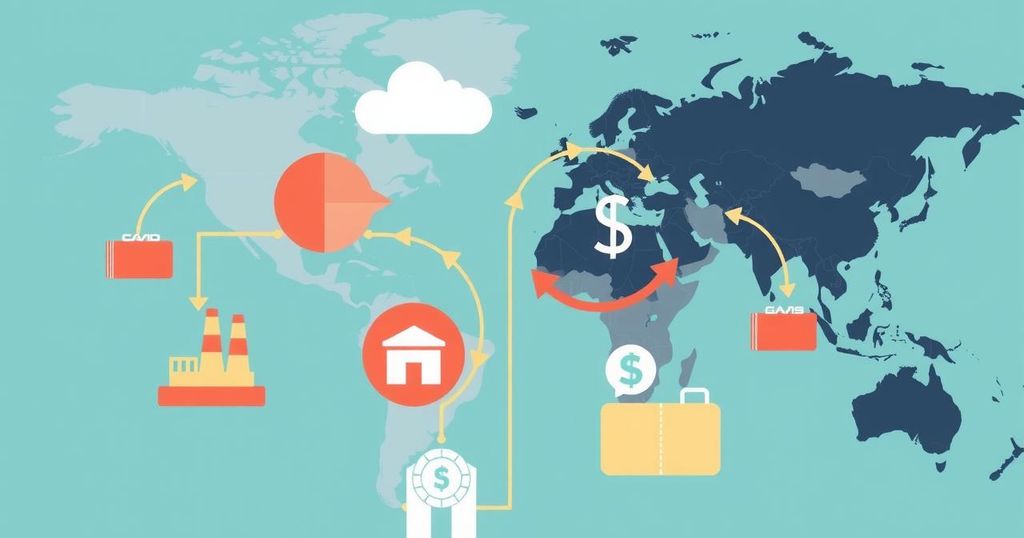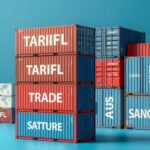Economy
Politics
AGE, AMERICA, ASIA, BANGLADESH, CAMBODIA, CENTRE FOR POLICY DIALOGUE, CHINA, DHAKA, DONALD TRUMP, EU, EXPORTS, FOREIGN INVESTMENT, INDIA, INTERNATIONAL TRADE, MEXICO, MUST, MUSTAFIZUR RAHMAN, NORTH AMERICA, PAKISTAN, SRI LANKA, SUPPLY CHAIN, TI, TRADE, TRUMP, UNITED STATES, US, VIETNAM, WORLD BANK, ZA
Clara Montgomery
U.S. Imposes 37% Tariff on Bangladeshi Exports, Raising Concerns
The U.S. has imposed a 37% tariff on Bangladeshi exports, worrying economists and exporters about economic impacts. Key figures advocate for diplomatic measures to mitigate these effects and clarify the claimed 74% tariff on Bangladeshi imports. Stakeholders emphasize the need to enhance competitiveness while negotiating tariff issues with the U.S., Bangladesh’s largest export market.
The United States has implemented a substantial 37 percent tariff on Bangladeshi exports, causing alarm regarding its economic ramifications and diminishing trade competitiveness for Bangladesh. Exporters and economists have called on the government to adopt both diplomatic and strategic measures to counteract these effects. They have expressed concerns regarding the calculation method used by the U.S. to assert that Bangladesh imposes a 74 percent tariff on its imports.
This new tariff structure, announced by President Donald Trump as part of broad global tariffs, is based on the assertion that the 74 percent tariff by Bangladesh justifies a reciprocal 37 percent tariff on its exports. Currently, most Bangladeshi goods face a 15 percent U.S. tariff. In 2024, Bangladesh exported approximately $8.4 billion in goods to the U.S., with ready-made garments contributing significantly to this figure.
Competitor nations also face steep tariffs, with China facing a 34 percent tariff, Vietnam 46 percent, Cambodia 49 percent, and Sri Lanka 44 percent, while India and Pakistan incur 26 percent and 29 percent tariffs respectively. Distinguished fellow at the Centre for Policy Dialogue, Mustafizur Rahman, indicated that the high tariffs would elevate the prices of Bangladeshi goods in the U.S., ultimately reducing their demand. Nevertheless, as competitors are also subjected to similar tariffs, the overall competitive landscape may not be significantly altered.
Rahman cautioned about the potential for a trade war, specifically highlighting the objections already raised by China and the European Union. He advocated for bilateral discussions to clarify the rationale behind the claimed 74 percent duty, especially given that Bangladesh imposes minimal tariffs on several U.S. imports. He also emphasized the importance of leveraging the Trade and Investment Cooperation Forum Agreement (TICFA) to enhance Bangladesh’s competitiveness in the global market.
Zahid Hussain, a former economist at the World Bank, shared similar concerns regarding the detrimental impact of the higher tariff on Bangladesh’s export levels due to decreased U.S. consumer demand. He noted that increased overall prices would diminish purchasing capacity among consumers. Hussain underlined the necessity for Bangladesh to negotiate the clarity of the tariff calculation while showcasing recent reforms that could seek an exemption.
South Asian Network on Economic Modelling’s executive director, Selim Raihan, raised alarms about the U.S. tariff calculations, expressing that the imposition signifies a structural shift within the global trading framework. He underscored that the new tariffs could adversely affect not only Bangladesh but also various other developing nations, particularly given that the U.S. is a crucial market for Bangladesh’s apparel sector.
Former president of the Bangladesh Garment Manufacturers and Exporters Association, Faruque Hassan, called for multifaceted approaches to resolve the tariff issue, questioning the U.S. justification for the 74 percent duty claim. Hassan highlighted that U.S. exports to Bangladesh primarily incur minimal tariffs, which underlines the need for negotiations rather than retaliatory measures.
Fazlul Haque, managing director of Plummy Fashion, expressed that while immediate pressures on prices from U.S. buyers are anticipated due to the new tariffs, the overall impact on Bangladesh’s apparel exports may not be as severe since many exports are basic garments. He stressed the importance of government support and stakeholder meetings to craft strategies for addressing these challenges.
Furthering this sentiment, Abdullah Hil Rakib, managing director of Team Pharma, conveyed hope that the government would take decisive actions to alleviate tariff pressures. Meanwhile, the press secretary to the chief adviser stated that ongoing engagements with the U.S. government are aimed at addressing the tariff concerns and rationalizing import tariffs from the United States.
The United States remains Bangladesh’s most significant export destination, underscoring the necessity of economic collaboration and negotiation to secure Bangladesh’s trade interests and mitigate adverse impacts arising from the imposed tariffs.
In summary, the imposition of a 37 percent tariff by the United States on Bangladeshi exports has raised grave concerns regarding the economic repercussions and trade competitiveness of Bangladesh. Economists and exporters alike call for strategic negotiations and diplomatic engagement to clarify the U.S. tariff calculations and seek relief, while addressing the need for competitive enhancements across various sectors. Maintaining collaboration with the U.S. is vital for ensuring the continued success of Bangladesh’s key export markets.
Original Source: www.newagebd.net








Post Comment